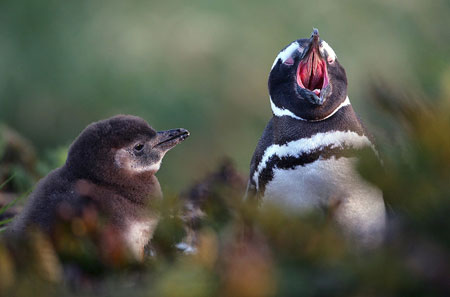News From:
There's probably a great Linux joke in here, but I'm not funny enough to come up with it. Technologist and former Microsoft executive Nathan Myhrvold visited the Falklands[ / Islas Malvinas], and took some amazing photographs of penguins and other creatures there. Dr. Myhrvold is CEO and managing director of Intellectual Ventures, a private entrepreneurial firm he founded with his former Microsoft colleague, Dr. Edward Jung. Snip from an essay about what he observed on the islands:
It turns out that there are some reasonably well developed scientific theories of cuteness.
Penguins look like little people – their bipedal stance, walking gait and proportions look like a tiny toy person. Self-love is something humans are good at, so it is natural to find these animals compelling. Their behaviors also happen to map well to human behavior – or at least one can naively imagine so because they are stereotypically similar to some of our own actions.
That covers penguins, but there are some more universal aspects of cuteness. I once studied to be a cartoonist (alas, I wasn’t funny enough) and in that field they have this very well figured out. The rule of thumb is that if you want a cartoon character to be cute, you draw it so that the total body height is between 2.5 and 3 times the height of the head. This gives you a Mickey Mouse, or Tweety Bird sort of character. You then make the eyes a large fraction of head height – little beady eyes are not cute. To make a heroic character – say Superman, Spiderman or Captain America you want 7.5 to 8 heads high. It always has amused me that being a pinhead looks heroic.
Link. Image: (c) 2007, Nathan Myhrvold. (Thanks, John Brockman)
Reader comment: Jeff says,
You should link to Mhyrvold's article on the future of digital photography, it's a must read. Direct link here. Excerpt:
I'm eagerly awaiting Canon's next move, probably to 25-plus megapixels. I'm what marketing people call an early adopter, but mark my words - you'll own a 16- or even a 25-megapixel point-and-shoot in a few years, and it will not stop there. By some estimates, your eyes have an effective resolution of more than 500 megapixels. If you can see it, why shouldn't a camera record it? The reason many pictures don't turn out is that in daytime the human eye can easily perceive a dynamic range of 10,000:1, while at night it is more like 1,000,000:1. Meanwhile, color slide film can record only about 32:1, and digital cameras, about 64:1.
In many situations, this forces a choice - do you expose for the light parts of the scene and let the dark parts go dead black, or save the shadows and turn the bright parts pure white? Future digital sensors will fix this, with ever broader dynamic range and greater light sensitivity (the ISO rating).
Focus is another problem. How many of your pictures wind up fuzzy? Autofocus technology can help, but cameras today still have a limitation on how much of a scene can be in focus at one time, known as depth of field. If you focus on the flower in front of you, the mountain in the background is apt to be fuzzy. Yet technically there is no reason we can't get essentially infinite depth of field, again by using more digital processing.
Javier Rodruiguez says,
My impression concerning your post would have been much better if you just said "Islas Malvinas" instead of Falklands (...) they always belonged to Argentina, not just a matter of sovereignty but simply geology (it's physically undeniable that they are inside South America's continental platform). I guess you regard colonialism as evil, as much as many of us do.


